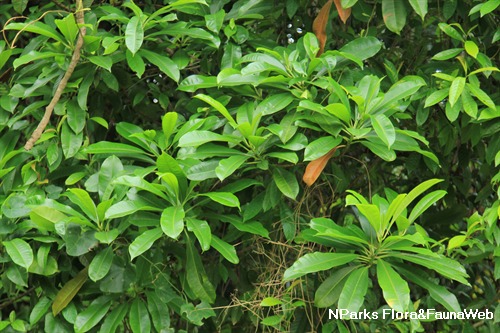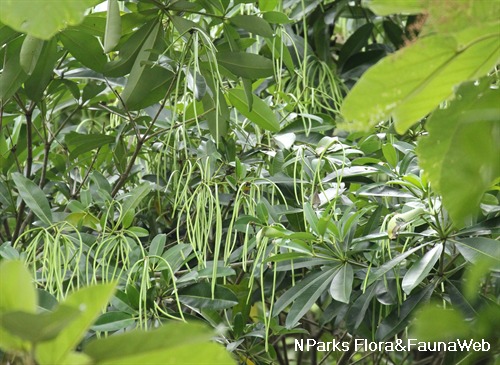_lowres.jpg)
Back
Alstonia angustifolia Miq.
| Family Name: | Apocynaceae |
| Synonyms: | Alstonia latifolia, Alstonia beccarii |
| Common Name: | Pulai Penipu Paya, Red-leaved Pulai, Hard Alstonia |
Alstonia angustifolia or Pulai Penipu Paya is a native tree of Singapore, measuring between 5 - 35 m tall. It has steep and tall buttresses, narrowly lance-shaped leaves, white, hairy fragrant flowers. Pulai Penipu Paya are planted in parks and gardens for its scented flowers.
Name
Classifications and Characteristics
| Plant Division | Angiosperms (Flowering Seed Plants) (Dicotyledon) |
|---|---|
| Plant Growth Form | Tree (Small (6m-15m)) |
| Lifespan (in Singapore) | Perennial |
| Mode of Nutrition | Autotrophic |
| Plant Shape | Conical |
| Maximum Height | 15 m |
Biogeography
| Native Distribution | Sumatra, Peninsular Malaysia, Singapore, Bangka Island, and Borneo |
|---|---|
| Native Habitat | Terrestrial (Primary Rainforest, Secondary Rainforest, Freshwater Swamp Forest) |
| Preferred Climate Zone | Tropical |
| Local Conservation Status | Native to Singapore (Least Concern (LC)) |
Description and Ethnobotany
| Growth Form | Small to medium sized tree 5-35m tall, with steep and tall buttresses |
|---|---|
| Trunk | Bark smooth, grey or somewhat brown, flaky or fissured |
| Foliage | Its 3-whorled, stalked leaves have somewhat leathery leaf blades that are narrowly lance-shaped, and 10–15 by 2.5–4.5 cm. |
| Flowers | It has a terminal inflorescence. Its fragrant flower have petals that are white and hairy. |
| Fruit | Its follicles are 50–70 cm long. Its seeds are oblong, pointed at one end, and 1 cm long. |
| Habitat | It grows in primary and secondary forests, peat swamps and hilly areas from sea level to 1,700 m altitude |
| Similar | It can be differentiated from Alstonia angustiloba by the venation. In Alstonia angustifolia, there are 10-15 (-20) pairs of lateral veins that are well spaced out, and form an acute angle of 80' or less with the mid rib. In A. angustiloba, the leaves have 30-60 (-70) pairs of closely spaced lateral veins that are almost perpendicular with the mid rib. In A. angustifolia, the venation between lateral veins (intercostal venation) is reticulate (net like) and can be seen sometimes on both surfaces, whereas it is inconspicuous in A. angustiloba. |
| Associated Fauna | It is pollinated by insects. |
| Cultivation | It can be propagated by seed. |
| Etymology | Latin Alstonia, commemorates Dr. Charles Alston (1685–1760), a professor of botany at Edinburgh University; Latin angustifolia means having narrow leaves |
| Ethnobotanical Uses | Medicinal: Traditional Medicinal Uses In Asia countries like Malaysia, the plant is used externally to overcome remittent fever by rubbing the leaves on the spleen area. <2> It is important to note that some therapeutic effects from traditional medicinal uses of plants are not currently supported or verified by scientific research. Similar to all Apocynaceae species, Alstonia angustifolia also contain white, milky sap which can cause allergic reactions especially for those with sensitive skins. Medical advice should be sought before use. Timber & Products: Its wood is pale brown, light, and soft. It is not durable, but used in building. |
Landscaping Features
| Landscaping | It is suitable for parks and streetscapes for its fragrant flowers. |
|---|---|
| Desirable Plant Features | Fragrant |
Fauna, Pollination and Dispersal
| Pollination Method(s) | Biotic (Fauna) |
|---|---|
| Seed or Spore Dispersal | Abiotic |
Plant Care and Propagation
| Light Preference | Full Sun |
|---|---|
| Water Preference | Moderate Water, Lots of Water |
| Plant Growth Rate | Moderate |
| Propagation Method | Seed |
Foliar
| Foliage Retention | Evergreen |
|---|---|
| Mature Foliage Colour(s) | Green |
| Mature Foliage Texture(s) | Leathery |
| Foliar Type | Simple / Unifoliate |
| Foliar Arrangement Along Stem | Whorled |
| Foliar Attachment to Stem | Petiolate |
| Foliar Shape(s) | Non-Palm Foliage (Lanceolate) |
| Foliar Venation | Pinnate / Net |
| Foliar Margin | Entire |
| Leaf Area Index (LAI) for Green Plot Ratio | 3.0 (Tree - Intermediate Canopy) |
Floral (Angiosperm)
| Flower & Plant Sexuality | Bisexual Flowers , Bisexual Flowers |
| Flower Colour(s) | White, Cream / Off-White, Pink |
|---|
| Flower Grouping | Cluster / Inflorescence |
| Flower Location | Axillary |
| Flower Symmetry | Radial |
| Individual Flower Shape | Trumpet-shaped |
| Inflorescence Type | Cyme |
| Flowering Habit | Polycarpic |
Fruit, Seed and Spore
| Mature Fruit Colour(s) | Brown |
|---|---|
| Fruit Classification | Simple Fruit |
| Fruit Type | Dehiscent Dry Fruit , Follicle |
References
| References | <1> Middleton, D.J (2007). Apocynaceae (Subfamilies Rauvolfioideae and Apocynoideae), Flora Malesiana, ser. 1, Seed Plants, vol. 18, Leiden: Rijksherbarium. <2> Zhao, M.X., Cai, J., Yang, Y., Xu, J., Liu, WY., Akihisa, T. Li, W., Kikuchi, T., Feng, F. & Zhang. J. (2023). Traditional uses, chemical composition and pharmacological activities of Alstonia R. Br. (Apocynaceae): A Review. Arabian Journal of Chemistry 16: 1-24. |
|---|
Image Repository
Others
| Master ID | 1410 |
|---|---|
| Species ID | 2703 |
| Flora Disclaimer | The information in this website has been compiled from reliable sources, such as reference works on medicinal plants. It is not a substitute for medical advice or treatment and NParks does not purport to provide any medical advice. Readers should always consult his/her physician before using or consuming a plant for medicinal purposes. |

_lowres.jpg)



_lowres.jpg)
